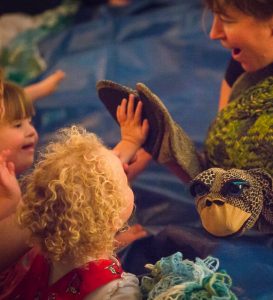Written by Francis Italiano, Sensorium Theatre – Australia
Sensorium Theatre is Australia’s premiere theatre company making work specifically designed for young audiences with disabilities. When we actively ask questions about our intended audiences’ particular needs, interests, preferred modes of engagement, cognitive strengths and receptive communication abilities we can end up expanding the parameters of the kind of theatre we offer them and how they might interact with it. When we add access and inclusion considerations for young people with disability as creative prompts, we can actually help generate whole new forms of performance with potential application for all sorts of audiences.
Our audience members are typically neuro-diverse. Some of them may have difficulty moving and communicating independently. For many of them, a Sensorium show might be their first experience of theatre. Taking up the challenge to create quality performances that engage and connect with this specific audience continuously prompts us as artists to re-configure how we tell stories, how we stage them, and how we can assist programmers to present them.
Francis Italiano
When we add access and inclusion considerations for young people with disability as creative prompts, we can actually help generate whole new forms of performance with potential application for all sorts of audiences.
Working with a multi-sensory palette, using touch, taste, smell, live music and a highly visual theatrical style, we use the sensory elements in our immersive installation-based shows (where the children are onstage with us) as cognitive “access points” into the narrative for our neuro-atypical audiences. So for example, if it rains in a forest story, the audience literally gets wet. If an audience goes deep-sea diving in an under-the-ocean adventure, they all take flashlights. When it’s time to co-pilot a spaceship each child pushes their own button to blast-off. Finding new ways to engage a new kind of audience offers new discoveries about what might constitute a “performance” for any young person.
Actively thinking about what each child’s experience of our shows might be has taken us down unique pathways (eg: How does a child with mobility issues navigate an immersive coral reef? Can a child with minimal hand dexterity sensor-activate spaceship control panels?) Similarly, focussing on our audience’s understanding and therefore enjoyment of and engagement with the work has seen us keep audience sizes small (15 children + accompanying adults) within our tactile interactive sets. This in turn, has meant that we’ve have had to work closely with presenters and programmers to shift their understanding of access and inclusion issues beyond physical needs into a more complex consideration of what access to meaningful arts experiences for young people with disabilities might look like.
Such a rigorous approach to creating transformative theatre-going experiences for our intended audience has brought about a paradigm shift for ourselves in terms of letting their responses to sensory stimuli inform our ideas of what a “show” can be and, importantly, prompting us to enlist young people as active participants in, rather than passive recipients of, the theatre experiences we create for them. Transforming our notions of what a theatre performance might entail allows us to witness transformation in our audiences. Time after time the parents, carers and educators of these children are struck by the unexpected creative responses that are sparked by their immersion in the sensory worlds Sensorium creates. While our work is targeted specifically at young people with neuro-diversity and disability, the elements of immersion, interactivity and agency have resonance for all sorts of young audiences.
About Sensorium Theatre
Sensorium Theatre is Australia’s only company making live shows specifically designed for young audiences with disabilities. Our aim is to improve the lives of children with disability by sparking their imaginations. Based in Western Australia, and formed in 2010, we have enchanted thousands of young people with disability with the magic of live theatre. We work with children with a range of access needs – including children on the autism spectrum and those with complex and multiple disabilities who may have limited movement and/or sensory impairment and complex communication needs. Our shows and programs are developed in collaboration with our target audience which ensures that they are tailored to our audiences’ specific needs. Our delivery model enhances this experience with pre-show and post-show “embedding” workshops and digital resources to maximise their understanding and enjoyment.



